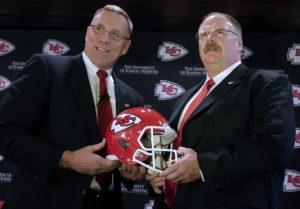Year Three can be a special number for a general manager and head coach when building a program or have the opposite effect as the final ride before unemployment.
By the third season, most of the roster should have their guys, players should know what is expected of them and the locker room culture should be built.

New Kansas City Chiefs general manager John Dorsey, left, poses with new head coach Andy Reid during an NFL football news conference announcing Dorsey’s hiring Monday, Jan. 14, 2013, in Kansas City, Mo. (AP Photo/Charlie Riedel)
The front office has a good grasp of their strengths and weaknesses on a roster. Coaches have fully installed their systems and a standard has been set in meeting, practices and game day.
Year Three is when the consistent playoff pushes arguably begin; Chiefs general manager John Dorsey and coach Andy Reid are now in that territory.
Before going forward, here is a look back at how four prior Chiefs head coaches have fared in the third season since 1991.
Marty Schottenheimer took over a franchise in 1989 that experienced one playoff game (1986) since the Hank Stram era. The Chiefs went 10-6 in Schottenheimer’s third year, winning a playoff game against the Oakland Raiders at Arrowhead Stadium. Kansas City fell short in the divisional round against the Buffalo Bills, but proceeded to appear in four consecutive postseasons.
Dick Vermeil took over the Chiefs in 2001, three seasons removed for the team’s last playoff appearance against the Denver Broncos in 1997. Kansas City found its way back to the only playoff game during the Vermeil era in 2003 with a home divisional game against the Indianapolis Colts. Peyton Manning and Greg Robinson ended that Super Bowl dream.
Herm Edwards began a rebuild during his third season in 2008 and the franchise experienced the worst record in team history at 2-14. But the draft that year saw rookies receive playing time, notably Jamaal Charles, Brandon Flowers, Brandon Carr, Branden Albert and Glenn Dorsey. Edwards was pushed out the door to begin the Scott Pioli era in 2009.
Todd Haley experienced a playoff appearance in his second year, leading to high hopes for the 2011 season. Rumors began to surface during the season, however, about tension between the general manager and head coach. Haley did not complete his third season and the team finished 7-9.
The third year is a very crucial season as noted, and here are the steps the Chiefs have taken under the current regime.
YEAR ONE
When Reid and Dorsey arrived in Kansas City, they inherited a roster that needed to learn how to consistently win.
Players needed to be held accountable for their play on the field, rather than what they said to the media.
Reid and Dorsey needed to find a quarterback who could run their system and be an extension of the coach on the field. They needed to get the organization and the locker room to buy into their way.
Above all else, the organization needed to reconnect with the fans.
The roster saw a great deal of turnover as 38 players did not return from 2012. Reid installed his offensive and defensive system, and emphasized how he wanted players to work and focus in meetings, practices and games.
Reid and Dorsey placed a big emphasis in the first year on creating competition at every position.
The results came quickly as the Chiefs reeled off nine consecutive wins to start the season before limping into the playoffs with an 11-5 record. Wildcard weekend against the Colts was a great opportunity for Reid and Dorsey to assess how the roster responded when it mattered.
Unfortunately, the second half of that game when the team blew a 28-point lead en route to a 45-44 loss illustrated a roster that had strides to make in closing out games.
YEAR TWO
Only 15 players returned from the roster inherited by Reid and Dorsey. With limited cap space, the staff elected to let eight free agents leave while replacing them with mid-tier players, journeymen or drafted rookies. Reid made clear early during the offseason workout program that the message was finishing each rep, play, series and game.
The team faced a daunting schedule in their second season, which presented a tremendous opportunity to gauge where the Kansas City roster was against potential playoff teams.
In the regular-season opener, the Chiefs looked a lot like the 2012 team that went 2-14. The team lacked urgency, execution and looked flat while losing Derrick Johnson and Mike DeVito, two of its better defenders, to season-ending Achilles injuries.
The coaching staff did a great job of tweaking their scheme to hide the weaknesses of their team. Offensive line struggles forced the offense to get the ball out quickly. Run blocking issues were overcome by creating multiple reads and misdirection for the defense to decipher.
The wide receivers’ inability to create separation was masked with bunch formations and clear-out routes for primary and secondary receivers. The highest priority was continually creating manageable down and distances with play calls that wouldn’t be sexy, but effective.
On the defensive side of the ball, the scheme needed to force opposing offenses to eat up clock and force field goals with stout red zone defense. Or the team needed to force quick three-and-outs to give the offense more possession opportunities. The aggressive style of defense had to be put on the backburner so the offense had a chance to grow and compete. Explosive plays against the defense would be a backbreaker and limit the chances for turnover opportunities.
The coaching staff put their roster in the best chance to compete despite deficiencies at multiple positions. The roster secured nine wins and potentially a repeat of the prior season record if a couple of plays fell their way. The experiences gained from the 2014 16-game schedule were just as valuable as a playoff appearance for the future.
YEAR THREE
The upcoming offseason is a crucial point for this program. The roster will collectively be made up of players who understand the expectations of the coaches, system and environment.
Dorsey can now get out from under some contracts that don’t fit from a production, philosophy or financial standpoint. Money can now be redistributed to positions of necessity for sustainable postseason success. The front office must aggressively attack the offensive line and receiver positions with immediate impact players.
Players joining the 2015 roster must understand and have the capability to push this team to a successful November and December.
The coaching staff has proven it can scheme victories for the first nine or 10 games regardless of deficiencies, going a combined 12-3 in September and October the past two seasons.
It is the final two months of the regular season that offseason additions must impact, especially when considering the Chiefs are a combined 8-9 in November and December the last two seasons.
The receivers lack explosive difference makers. The offensive line needs help in passing off stunts, effective versatility in their run blocking style and ability to get out into space.
Collectively the team must improve its desire to win every play and enhance intensity. If the roster refuses to fail on any given play, the true competition that Reid and Dorsey envisioned can finally begin.
The roster is at the point where it has the potential to win the AFC West and its first playoff game since January 16, 1994. It just needs a swift kick and a few additions to reach full potential.
Year Three can be a huge payoff or a cruel reminder of how far this team has to go.
Either way, the clock is ticking.
